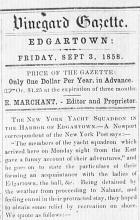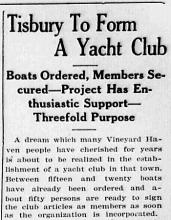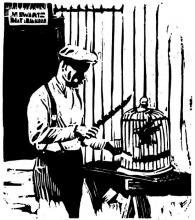The coming of the New York Yacht Club cruising fleet stirs never-to-be-forgotten memories. It is bewildering to realize how many persons cannot recall this scene, not having been born at the time, and thus cannot without difficulty follow a description by one whose emotions were deeply stirred by the sight sixty-five years ago.
The fleet did not always rendezvous at Vineyard Haven, yet that harbor was favored and the club’s own shore base was erected on the Eastville shore maintained by a club steward who was a year-round resident of Oak Bluffs.
There were many Islanders, year-round and seasonal, who never knew exactly when this great fleet was due but they always knew when it was approaching Vineyard Haven for the reason that the shore base “dressed up” well in advance of the anticipated arrival, with tall mast and signal-yard filled with flags from the truck to the “dead-men” which secured the stays to the ground. From that time until the fleet’s arrival, the headlands of the Island were sought by those who must view this marine parade from the shore, and boats and vessels of various sizes, put off into Vineyard Sound to welcome the arrivals, each with its ensign displayed at truck or peak.
Islanders Held Little Interest
The fleet raced into Vineyard Haven then as now, but the finish of the races held little interest for the Islanders who were engrossed in the show regardless of who might have won.
The arrival may or may not have been a thrilling sight, depending upon the weather, for the fleet was largely composed of sailing craft and not auxiliaries. Weather conditions governed the movements and the spectacle.
The big steam tender might have made port and come to anchor some time before the others, but the emergency craft, small, tug-like vessels, carrying emergency-gear, kept abreast of the flank of the formation, ready to bear a hand if it should be required. Actually, then, the real show was on after the fleet had come to anchor in rows across the harbor, filling the lower anchorage until the occasional coaster that might have been laying there was closely hemmed in.
The yacht of that time differed in size, rig and cut of sails from that of the present. The Marconi sail was not yet known; virtually all working sails were gaff-rigged, and light canvas differed except for the spinnaker, or balloon-jib, which were sometimes seen.
Sloop-rigs on the large yachts were rare. The America’s Cup defender Columbia, perhaps the first defender of that name, is recalled as a huge, spoon-bowed craft, with a single mast, cutter-rigged. She carried an extremely large club-tops’l, necessitating an extension to her already lofty topm’st, and another extension to her gaff, which was rigged in a fashion similar to a studding-s’l-boom on the yardarm of a square-rigged ship.
There Were Many Schooners
But there were many schooners, and the clipper bow with its decorated trail-boards was the prevailing design. All such schooners carried gaff-tops’ls, and fishermen’s stays’ls.
As many as half a dozen brigantines might be seen with this fleet, and an occasional baroque-rig graced the assembly, its yards polished, pendants silver-plated, and “doublings” a glistening white against the varnished portions of lower m’st, topm’st and top-gallant.
There were steam yachts, the lordly Corsair of J. P. Morgan, looming majestically above all, her black sides gleaming, and her rows of portholes shining like gold.
There were others, most painted white, and one, an imitation of naval craft is recalled, with buff upperworks, such as the Navy affected in peacetime, raking stacks, and even brass cannon, several in number. She was a long, low-sided craft, which appeared always to be making a high rate of speed even if she wasn’t.
There were followers of the fleet: pleasure craft, small and large, which trailed along, and not the least of these were the catboats, many of them rigged with a bowsprit as long as the boat itself, upon which were set huge jibs in light weather. There were also schooners and Eastern sloops which may have been fishermen or coasting vessels, chartered for the cruise; certainly they lacked polish and style although they were doubtless able craft.
As soon as the anchors were down and the sails given a “harbor furl,” traffic with the shore, began, and here again was offered a contrast with the similar scene of today.
One or More Steam Launches
A;; the larger yachts carried one or more steam launches; highly varnished, open crafts, their brass boilers gleaming in the sun as they moved through the waters as smoothly as swimming dick and with no more sound than a whisper. Two hands and a coxswain comprised the crew of such a launch, all in white uniforms, and, docking alongside of the landings, the two hands held the launch with their boat-hooks, to allow the passengers to land or embark.
Naturally, all male passengers wore uniforms with as much gold braid as a naval commodore and were accorded as many courtesies, even on some yachts to having the gangways piped as they came over the side.
The display when the fleet “dressed-ship” can never be duplicated by the yacht most common today. The single-stickers with which all are familiar, called “toothpicks” by old-timers of sixty-five years ago, do their best when they send up their flag-hoists, but the schooners and brigs of yesterday, the steam yachts with their two masts, would fill the stays with flags from the tip of the bowsprit to the tip of the spanker-boom, including a specially-rigged spring-stay between the fore and main trucks. The sight was gay indeed.
A gun and shrill piping by the bosuns signaled the lowering of ensigns and the setting of riding-lights, and the anchored fleet looked like a city afloat after the darkness fell, with the running-lights of launches moving from one to another throughout the fleet, and music sounding from many an illuminated quarterdeck.
The sailing fleet was handled by skippers and other officers who were deeply interested in wind and canvas. Aside from racing, the fleet moved under sail from necessity, and anything which offered a new idea regarding sail, interested these yachtsmen to a far greater degree than would be possible today.
One summer long ago the yacht club fleet was making the mouth of the Sound, bound into Vineyard Haven. It was night, the wind was light but the flood-tide was making fair for the yachts. Out of the shadows astern came the seventy-ton coasting schooner, John B. Norris, owned by Capt. Benjamin C. Cromwell of Vineyard Haven.
Beamy and Shoal Draft
A beamy, shoal-draft vessel, with a centerboard, she carried her regular four “lowers” and a gaff-tops’l on her main.
With never fuss nor flurry, she overhauled the yacht fleet, picked her way through it, passing the yachts, one by one, replying to hails only with a return greeting, and when the yacht fleet made Vineyard Haven, they found the Norris already there, at anchor as she had been for some time.
Masters, pilots, owners and race committees came aboard the Norris the next day, asking what sort of auxiliary power she might carry and begging a glimpse of it. They shook their heads in bewilderment when examination of her bilges disclosed merely empty space; in brief, the clumsy-looking old coaster had out-sailed the yacht fleet, showing them all a clean pair of heels.
The probability is that the skipper of the Norris was as much surprised as the skippers of the yachts she passed, although the vessel did have the name of being “slippery.”
This was sixty-five years ago. Yachts are far more common in Island waters today. They are smaller by far, and therefore not nearly so impressive. Most are auxiliaries, which drop their sails and proceed under power when the wind lets go, and there are few today which carry paid hands who wear uniforms and salute owners as they come over the gangway.
Sailing is still popular, perhaps interesting even more individuals than it did sixty-five years ago, as a sport, but much of the romance of sailing either for sport or commercial purposes has been scrapped, along with gaff-rigged sails, yards, clipper bows and steam-cutters.
Only in the memory of old-timers does the old romance still live, beautiful, despite inefficiency, absence of mechanism and the many shortcomings peculiar to a day that is gone.










Comments